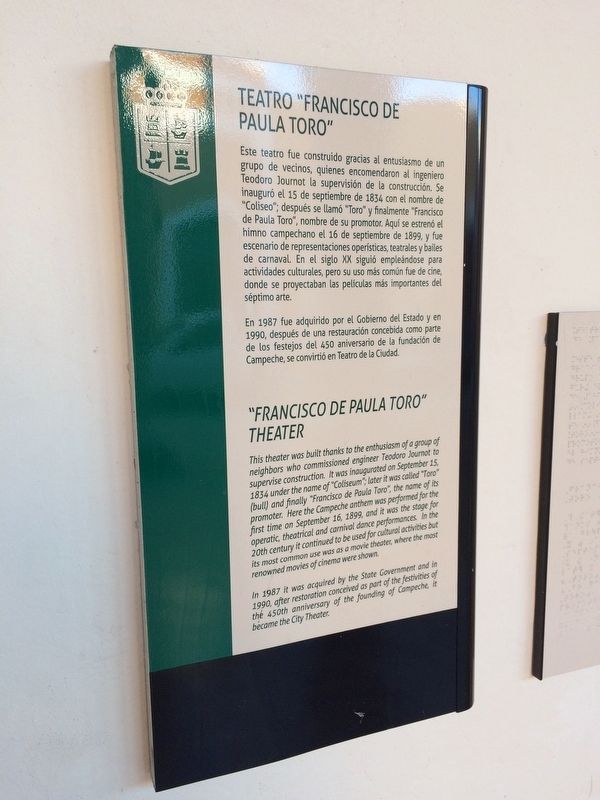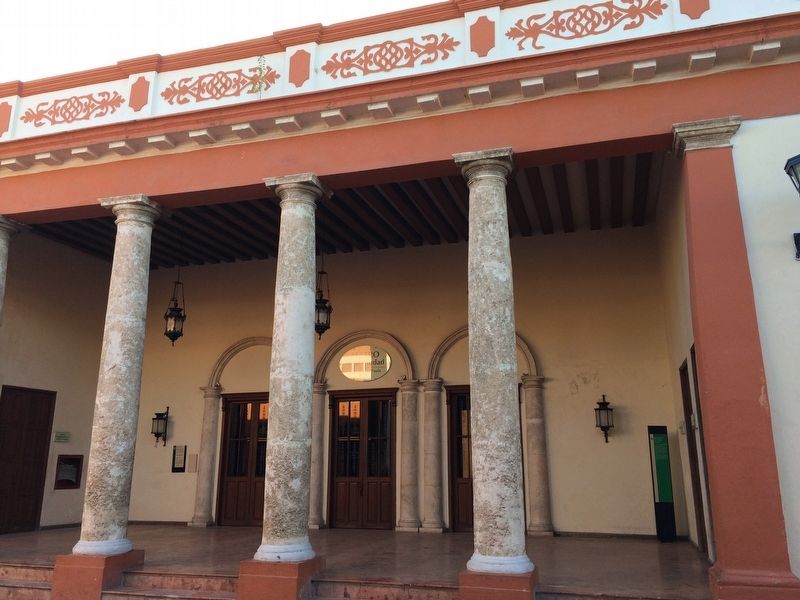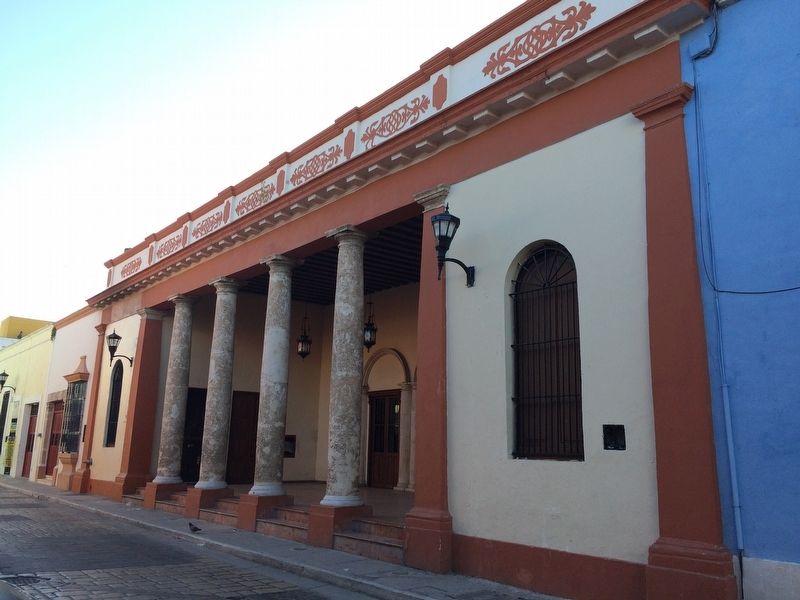Zona Centro in San Francisco de Campeche in Campeche, Mexico — The Southeast (Yucatan Peninsula)
Francisco de Paulo Toro Theater
Inscription.
Teatro “Francisco de Paula Toro”
Este teatro fue construido gracias al entusiasmo de un grupo de vecinos, quienes encomendaron al ingeniero Teodoro Journot la supervisión de la construcción. Se inauguró el 15 de septiembre de 1834 con el nombre de "Coliseo"; después se llamó "Toro" y finalmente "Francisco de Paula Toro", nombre de su promotor. Aquí se estrenó el himno campechano el 16 de septiembre de 1899, y fue escenario de representaciones operísticas, teatrales y bailes de carnaval. En el siglo XX siguió empleándose para actividades culturales, pero su uso más común fue de cine donde se proyectaban las películas más importantes de séptimo arte.
En 1987 fue adquirido por el Gobierno del Estado y en 1990, después de una restauración concebida como parte de los festejos del 450 aniversario de la fundación de Campeche, se convirtió en Teatro de la Ciudad.
English:
"Francisco de Paula Toro" Theater
This theater was built thanks to the enthusiasm of a group of neighbors who commissioned engineer Teodoro Journot to supervise construction. It was inaugurated on September 15, 1834 under the name “Coliseum”; later it was called “Toro” (bull) and finally “Francisco de Paula Toro”, the name of its promoter. Here the Campeche anthem was performed for the first time on September 16, 1899, and it was the stage for operatic, theatrical and carnival dance performances. In the 20th century it continued to be used for cultural activities but its most common use was as a movie theater, where the most renowned movies of cinema were shown.
In 1987 it was acquired by the State Government and in 1990, after restoration conceived as part of the festivities of the 450th anniversary of the founding of Campeche, it became the City Theater.
Topics. This historical marker is listed in these topic lists: Arts, Letters, Music • Man-Made Features. A significant historical year for this entry is 1834.
Location. 19° 50.735′ N, 90° 32.078′ W. Marker is in San Francisco de Campeche, Campeche. It is in Zona Centro. Marker is on Calle 12, on the right when traveling east. Touch for map. Marker is at or near this postal address: Calle 12 139, San Francisco de Campeche CAMP 24000, Mexico. Touch for directions.
Other nearby markers. At least 8 other markers are within walking distance of this marker. Temple of the Sweet Name of Jesus (about 150 meters away, measured in a direct line); The Guadalupe Gate (about 150 meters away); Park of the 4th Centenary San Martín (about 210 meters away); Independence Square (about 240 meters away); Bastion of Santiago (about 240 meters away); "La Española" Chapel (approx. 0.2 kilometers away); Campeche Library
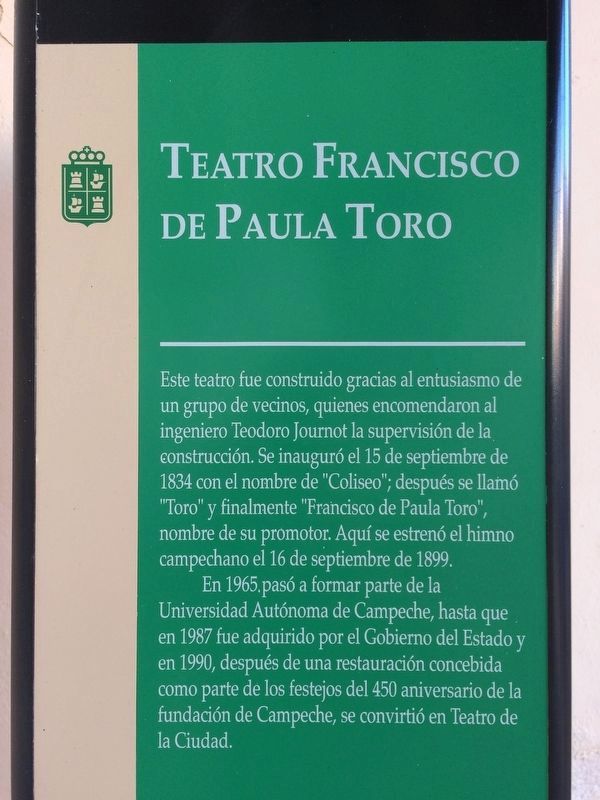
Photographed By J. Makali Bruton, January 10, 2017
2. Additional Francisco de Paulo Toro Theater Marker
This additional marker, to the far right of the featured marker, has slightly different Spanish and English text. In Spanish it reads: Teatro “Francisco de Paula Toro”
Este teatro fue construido gracias al entusiasmo de un grupo de vecinos, quienes encomendaron al ingeniero Teodoro Journot la supervisión de la construcción. Se inauguró el 15 de septiembre de 1834 con el nombre de "Coliseo"; después se llamó “Toro" y finalmente "Francisco de Paula Toro”, nombre de su promotor. Aquí se estrenó el himno campechano el 16 de septiembre de 1899.
En 1965, pasó a formar parte de la Universidad Autónoma de Campeche, hasta que en 1987 fue adquirido por el Gobierno del Estado y en 1990, después de una restauración concebida como parte de los festejos del 450 aniversario de la fundación de Campeche, se convirtió en Teatro de la Ciudad.
Este teatro fue construido gracias al entusiasmo de un grupo de vecinos, quienes encomendaron al ingeniero Teodoro Journot la supervisión de la construcción. Se inauguró el 15 de septiembre de 1834 con el nombre de "Coliseo"; después se llamó “Toro" y finalmente "Francisco de Paula Toro”, nombre de su promotor. Aquí se estrenó el himno campechano el 16 de septiembre de 1899.
En 1965, pasó a formar parte de la Universidad Autónoma de Campeche, hasta que en 1987 fue adquirido por el Gobierno del Estado y en 1990, después de una restauración concebida como parte de los festejos del 450 aniversario de la fundación de Campeche, se convirtió en Teatro de la Ciudad.
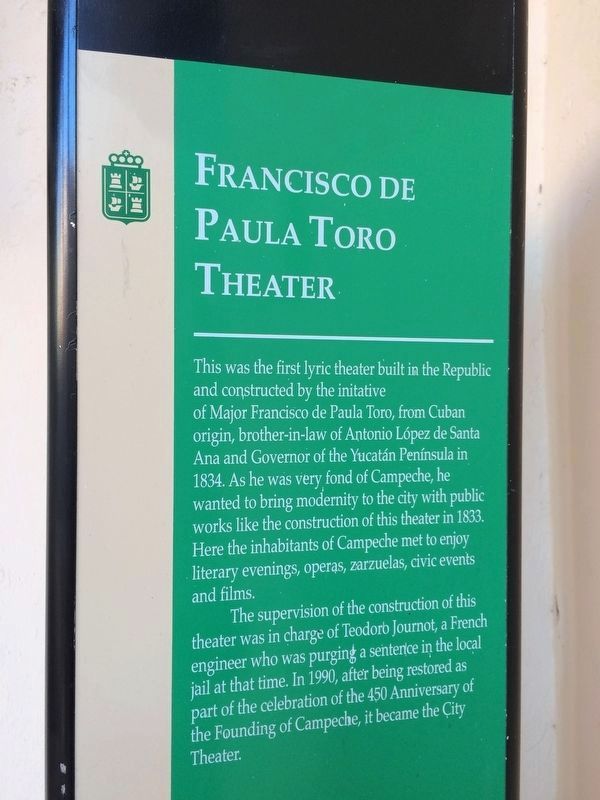
Photographed By J. Makali Bruton, January 10, 2017
3. English text of additional Francisco de Paulo Toro Theater Marker
The English text of this additional marker to the far right of the featured marker is slightly different. It reads: Francisco de Paulo Toro Theater
This was the first lyric theater built in the Republic and constructed by the initative of Major Francisco de Paula Toro, from Cuban origin, brother-in-law of Antonio López de Santa Ana and Governor of the Yucatán Península in 1834. As he was very fond of Campeche, he wanted to bring modernity to the city with public works like the construction of this theater in 1833. Here the inhabitants of Campeche met to enjoy literary evenings, operas, zarzuelas, civic events and films.
The supervision of the construction of this theater was in charge of Teodoro Journot, a French engineer who was purging a sentence in the local jail at that time. In 1990, after being restored as part of the celebration of the 450 Anniversary of the Founding of Campeche, it became the City Theater.
This was the first lyric theater built in the Republic and constructed by the initative of Major Francisco de Paula Toro, from Cuban origin, brother-in-law of Antonio López de Santa Ana and Governor of the Yucatán Península in 1834. As he was very fond of Campeche, he wanted to bring modernity to the city with public works like the construction of this theater in 1833. Here the inhabitants of Campeche met to enjoy literary evenings, operas, zarzuelas, civic events and films.
The supervision of the construction of this theater was in charge of Teodoro Journot, a French engineer who was purging a sentence in the local jail at that time. In 1990, after being restored as part of the celebration of the 450 Anniversary of the Founding of Campeche, it became the City Theater.
Credits. This page was last revised on January 28, 2017. It was originally submitted on January 28, 2017, by J. Makali Bruton of Accra, Ghana. This page has been viewed 324 times since then and 11 times this year. Photos: 1, 2, 3, 4, 5. submitted on January 28, 2017, by J. Makali Bruton of Accra, Ghana.
